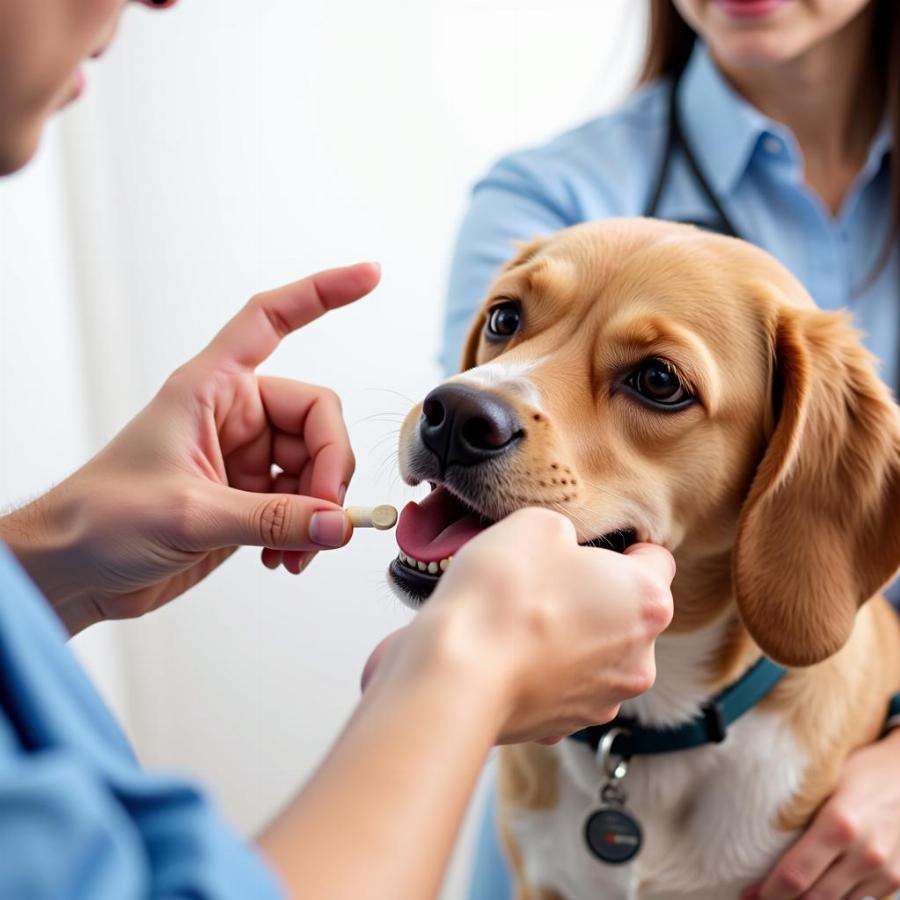Clopidogrel for dogs, often sold under the brand name Plavix, is a medication primarily used to prevent blood clots. This antiplatelet drug works by inhibiting the clumping action of platelets, reducing the risk of thrombus formation. While beneficial in certain situations, it’s crucial to understand its uses, potential side effects, and necessary precautions. This guide will provide a comprehensive overview of clopidogrel for dogs, empowering owners to make informed decisions regarding their furry companions’ health.
Understanding Clopidogrel and its Uses in Canine Health
When your veterinarian prescribes clopidogrel for your dog, it’s typically to address specific conditions that increase the risk of blood clots. These conditions can range from heart disease and certain cancers to immune-mediated disorders. Clopidogrel can also be administered after surgery, particularly those involving the cardiovascular system, to minimize the chances of post-operative clotting. One common use is in conjunction with aspirin, potentially providing synergistic effects in preventing clot formation. However, combining these medications should only be done under strict veterinary supervision. What are the specific instances where clopidogrel becomes a necessary treatment option?
When is Clopidogrel Prescribed for Dogs?
- Heart Conditions: Dogs with certain heart diseases, such as atrial fibrillation or cardiomyopathy, are at a higher risk of developing blood clots. Clopidogrel helps mitigate this risk, improving blood flow and reducing the chances of stroke or other thromboembolic events.
- Cancer: Some cancers, especially hemangiosarcoma, a malignant tumor of the blood vessels, can predispose dogs to clotting. Clopidogrel can be part of a comprehensive treatment plan to manage this risk.
- Immune-Mediated Disorders: In some cases, immune-mediated disorders can lead to abnormal blood clotting. Clopidogrel can be used to help regulate this process and prevent complications.
- Post-Operative Care: Following certain surgeries, particularly those involving the heart or blood vessels, clopidogrel can be prescribed to prevent clot formation and promote healing.
Potential Side Effects and Precautions for Clopidogrel in Dogs
While generally considered safe, clopidogrel, like any medication, can have potential side effects. These are usually mild and infrequent, but it’s essential to be aware of them. Common side effects include gastrointestinal upset, such as vomiting or diarrhea. Less commonly, more serious side effects like bleeding disorders or anemia can occur. Is your dog exhibiting any unusual symptoms after starting clopidogrel? Immediate veterinary attention is critical if you observe any signs of bleeding, such as pale gums, lethargy, or difficulty breathing.
Monitoring Your Dog on Clopidogrel
Regular veterinary checkups are crucial while your dog is on clopidogrel. These checkups allow your veterinarian to monitor blood cell counts and assess the effectiveness of the medication. Inform your veterinarian about any other medications or supplements your dog is taking, as interactions can occur. Never adjust the dosage or discontinue the medication without consulting your veterinarian.
Administering Clopidogrel to Your Dog
Clopidogrel is typically given orally, once or twice daily, as directed by your veterinarian. It can be administered with or without food. However, if your dog experiences stomach upset, giving the medication with food may help. Make sure your dog has access to fresh water at all times. Never crush or split the tablets unless specifically instructed by your veterinarian. Accurate dosing is crucial for the medication’s effectiveness and to minimize the risk of side effects.
What to do if you miss a dose?
If you miss a dose, give it as soon as you remember. However, if it’s almost time for the next dose, skip the missed dose and continue with the regular schedule. Never double the dose to catch up. Consistent administration is key to ensuring the medication’s efficacy.
 Dog owner administering clopidogrel to their dog
Dog owner administering clopidogrel to their dog
Conclusion: Ensuring Your Dog’s Well-being with Clopidogrel
Clopidogrel can be a vital tool in managing various health conditions in dogs. By understanding its uses, potential side effects, and administration guidelines, you can help ensure your furry friend receives the best possible care. Always consult with your veterinarian for personalized advice regarding clopidogrel for dogs, and never hesitate to ask questions about your dog’s health.
FAQ: Common Questions about Clopidogrel for Dogs
- Can clopidogrel be given with other medications? Consult your veterinarian as some medications can interact with clopidogrel.
- What should I do if my dog experiences side effects? Contact your veterinarian immediately if your dog shows any adverse reactions.
- How long will my dog need to take clopidogrel? The duration of treatment varies depending on the underlying condition.
- Is there a generic version of clopidogrel available? Yes, generic versions are often available and are typically more affordable.
- Can I stop giving clopidogrel if my dog seems better? Never discontinue the medication without consulting your veterinarian, even if your dog appears to have improved.
- Are there any natural alternatives to clopidogrel for dogs? While some natural remedies may have antiplatelet properties, always consult your veterinarian before using any alternative therapies.
- How is clopidogrel stored? Store clopidogrel at room temperature, away from moisture and direct sunlight.
Beaut Dogs is your trusted source for comprehensive information on dog care, offering expert advice and resources to help you navigate the world of canine companionship. For personalized guidance regarding clopidogrel for dogs or any other canine health concerns, please contact us at [email protected]. We are committed to providing accurate and up-to-date information to ensure the well-being of your beloved pet. Visit Beaut Dogs at https://beautdogs.com for more insightful articles and expert tips on caring for your canine companion.